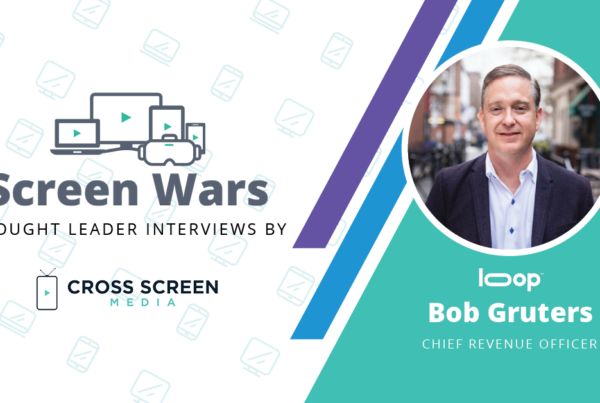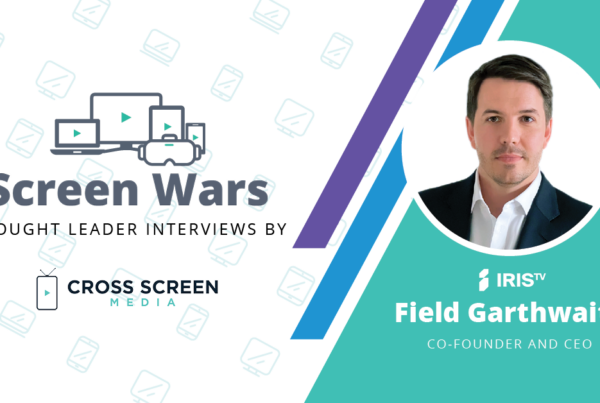Nielsen’s Dave Hohman joins Cross Screen Media’s Michael Beach to share his unique insights on developments, trends, and challenges across the Convergent TV Space in our latest Screen Wars Thought Leader Interview. Full transcript below.
Michael Beach: Today we are pleased to have Dave Hohman, the Executive Vice President, Managing Director of Demand Side Media, Nielsen join us. Let’s start off with one of our icebreakers that we like to ask everybody: What was your first job? And what lessons did you take away from it applied to your career?
Dave Hohman: I joined the Marine Corps right out of high school. And I would say that was probably the defining lesson that I learned. In addition to self-motivation and self-discipline, I think the thing that I’ve carried through my career most is servant leadership, the idea that you’re only as fast as your slowest team member, that training, collaboration and cooperation is key, and that as a leader, your job is to set a vision and provide the resources that are necessary for your team to do their job. Remove the barriers that get in the way of their being able to do their job and then getting out of their way and letting them do it. And that has served me really well in my career.
MB: How did you get your start in the conversion TV space?
DH: My career took a path based on opportunities that presented themselves. I’m somebody that looks at an opportunity as an open door and I want to find out what’s on the other side before the door gets slammed in my face. My first job out of the Marines when I left was working for a super-regional bank, and I got involved in database marketing in that regard. From there, my career moved from a couple of different client side businesses into the agency space. And then I was ultimately hired by Nielsen to come and run the agency business. And that then expanded into the demand side of media.
MB: Seeing both the demand side and then Nielsen as the core currency of the supply side as well, what have you seen as the biggest changes in the video ad marketplace?
DH: I think the biggest change is the explosion of different video platforms and for a variety of reasons. In the 80s you had cable companies and cable news, in the 90s you had DVRs, and in the early 2000s, that was becoming more and more prevalent, so that time shifting became something that we had to deal with. And then with the end of the 2000s you had the adoption of mobile devices, smartphones, etc. Add to that the availability of faster broadband and I think streaming has become kind of the new change. And from a consumer perspective, video is video. They don’t make the distinction anymore between television and digital video and streaming. It’s what they want to watch when they want to watch it and where it’s available. And I think that the changes today are more about live and on-demand. And even live programming like sports is often streamed on a mobile device. So there’s this convergence of device and content and consumer behavior that’s been facilitated by the adoption of technology and broadband services.
MB: We’ve featured several recent reports from Nielsen, including the total audience report, about streaming media and total streaming minutes. Obviously there’s been a ton of change; how has Nielsen adapted to this new environment?
DH: Nielsen has consistently been looking at what consumers engage with from both a content and an advertising standpoint; it’s just gotten a lot more complicated because of the fragmentation of media. Advertisers are interested in being able to engage with the consumer where they are. And in order to do that, they need to know what content they’re watching, and then what kind of ads behave or perform more effectively in different places on different platforms. And so, from Nielsen’s standpoint, our job really hasn’t changed that much. It’s just gotten a lot harder, it’s a lot more challenging to be able to do that. Ultimately, what we’re working towards is cross media measurement where you have a consistent and comparable ability to measure what people are engaging with, de-duplicated at a person level, because what you’ve got is advertisers wanting to do is to optimize their reach and frequency across all of those platforms and you want media owners to be able to effectively have yield optimization. And in order to do that, you’ve got to know what people are engaging with and where. So Nielsen’s movement towards cross media measurement is being driven by a lot of technological advances internally; one platform, one data architecture, one panel, that’s the direction that we’re moving so that everything is consistent because the harmonization of all of that data, and then the de-duplication of all of that data, is the only way that you can get to that ultimate goal.
MB: I think that’s the biggest trend in media and something that our user base is excited about. What areas of the commercial TV space are you most excited about? In one year and in five years, what do you think we’re going to be talking about as the biggest thing?
DH: I think that you’re going to see a rapid acceleration towards cross media measurement that is truly comparable across platforms to facilitate optimization of reach, frequency, and yield management. What I’m most excited about is a pilot that we’re doing right now with advanced video advertising. And we’ve got all of the major US programmers that are engaged in that pilot, and we’re talking to advertisers and agencies, particularly those that have the availability of first and third party data, to be able to do dynamic ad insertion within the entire commercial load on linear TV. I think that is going to be game changing for a variety of reasons. And when you think about the changes in the industry, it isn’t any longer different players, you’ve got 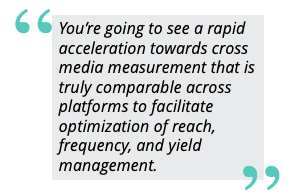 broadcasters, cable companies and streaming services. They’re all owned by the same company, right? So being able to provide that capability so that a user has a seamless experience across devices, across platforms, that will no longer get them to a situation where they’re fatigued by seeing the same commercial over and over again on different platforms, that allows for media owners to optimize their yield management and to have advertisers be able to engage with consumers where they are, potentially even having sequential advertising across an experience. This is exciting to me because it makes advertising much more relevant and much more effective. And the reality is that advertising supports a lot of the content that gets developed and shared and distributed throughout the ecosystem. Without it, I think we have a lot fewer options than we do with it.
broadcasters, cable companies and streaming services. They’re all owned by the same company, right? So being able to provide that capability so that a user has a seamless experience across devices, across platforms, that will no longer get them to a situation where they’re fatigued by seeing the same commercial over and over again on different platforms, that allows for media owners to optimize their yield management and to have advertisers be able to engage with consumers where they are, potentially even having sequential advertising across an experience. This is exciting to me because it makes advertising much more relevant and much more effective. And the reality is that advertising supports a lot of the content that gets developed and shared and distributed throughout the ecosystem. Without it, I think we have a lot fewer options than we do with it.
MB: As you look to the future, and everyone is excited about taking that roughly 16 minutes an hour or so of national TV time and making it addressable, do you think people look at that as more of a digital ad? I know that the terminology is starting to emerge but one thing that we see is teams are still siloed off. Are you getting more interest from the digital side or the more traditional linear planning side?
DH: I think that the reality is that centralization of that function in the agencies and advertisers is becoming more the norm than that separation. I think there’s a real understanding that consumers don’t differentiate by platform or opportunity, so why should the industry? As I said, a lot of the different platforms are even owned by the same company. So you’ve got buyers now that are doing fluidity buys that are a combination of linear TV and digital and streaming. The intent, I think, is to engage with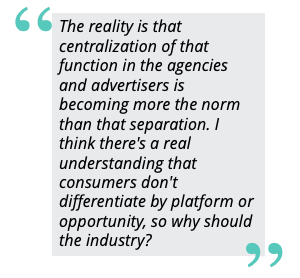 a consumer where they are and on the content that they’re most engaged with, with the kinds of ads that they want to see because they’re more relevant, rather than bombarding them with the same ad over and over and over again. That’s a way to improve the delivery of ads. And I don’t think it’s a digital or linear conversation anymore. It’s a video conversation.
a consumer where they are and on the content that they’re most engaged with, with the kinds of ads that they want to see because they’re more relevant, rather than bombarding them with the same ad over and over and over again. That’s a way to improve the delivery of ads. And I don’t think it’s a digital or linear conversation anymore. It’s a video conversation.
MB: Another big trend is cord cutting or cord shaving. A couple years ago, we wrote a lot about people shifting to these virtual pay TV packages and that hasn’t really materialized even though they’ve grown quite rapidly. What strategy do you think media buyers and networks should employ to handle this new environment?
DH: I think having sophisticated planning tools is incredibly important. I think being able to merge their data, whether it’s the advertisers first party point of sale data, or any kind of engagement data that Nielsen has through our measurement services, or even third party syndicated data, to be able to pull that together and plan and buy based on specific audiences, behavioral attributes that they’ve exhibited, and being able to do that both across linear and digital, so that you can follow an audience more effectively. That’s a strategy that I’m seeing employed more and more and data driven advertising even in linear TV is not new for Nielsen. We’ve been doing data merges with advertisers and agencies, between their clients’ data or their first party data and our engagement data in order to create both custom and syndicated segments for activation.
MB: What do you think are the biggest areas that media buyers could have in making the shift? What are the most immediate steps they need to take?
DH: I think having a clear understanding of the objectives of their campaign and what it is that they want to be able to achieve. Having a strong marketing mix, understanding of channel allocation and that they have increasingly limited budgets in order to achieve their objectives. So where do I get the most bang for the buck, and then putting together a media plan that delivers ads in the right places, based on what those objectives are, and where they’ve been shown to be most effective in measurement and in previous campaigns. It’s taking what they’ve learned using the data that they have and creating a media plan that works across platforms in the most efficient, effective way.
MB: Anything you want to add on the leadership role that Nielsen is taking on innovation on the addressable TV side and the overall vision for where that’s going?
DH: I think the way that a lot of advertisers and agencies are looking at advertising now is rather than filling in with addressable where they can, it’s trying to put together a plan that can take advantage of the use of data to be much more effective in targeting their audiences across a multitude of platforms. The vision for being able to do that is dependent on consistent and comparable measurement across those platforms. And it needs to be able to be de-duplicated at an individual level.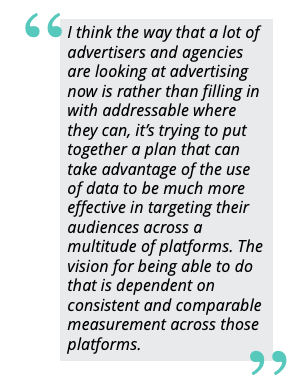
Nielsen’s direction in future proofing the measurement capability is being impacted by privacy legislation and the number of new changes in the environment like cookieless web and the elimination of IDFA. It’s being able to create in a privacy safe way, both transparently and safely, a comparable transparent measurement that can be used by planners and buyers as well as media owners to really understand what people are engaging with where they are, and being able to do a like-for-like comparison. If I’m hitting optimization on linear TV in my marketing mix, and I want to find complementary places that will either increase my reach incrementally or improve my frequency management, then how do I do that effectively without that measurement? That’s really the direction that Nielsen is going. And I’m excited about the changes that are coming. Because if you look at a timeline of technology change and measurement change, there was a “set it and forget it” mentality from a few decades ago to change that is almost impossible to keep pace with. Looking out towards where the industry is going and developing for that, I think is what I’m most excited about.
MB: Nielsen recently announced some significant changes to the cross platform measurement and optimization capabilities. Can you give a little bit of background on this and the opportunity?
DH: It’s the changes in the industry that are being driven by privacy legislation, and by concerns about being able to re-identify individuals using personal identifiable information, whether it’s a device ID or cookies or a variety of other things. Those changes are changing the way that advertisers can both see where their ads are being displayed and to whom, and optimizing against them. So again, our foundation for future proof measurement is focused on phasing in a new methodology that ensures comparability, transparency across the third parties in the open web, broadening the coverage of our reporting within personal and connected devices, but also fosters more of a resilience in measurement that’s not dependent on any one party or any one external source that is unreliable as a digital identifier. It’s about being able to identify content, having an effective ID solution, and then putting it together with a measurement system that is on a single platform and is comparable across all of the media types. That’s really the objective of what Nielsen is going to be doing probably for the next few years.
MB: Anything else that would be helpful to highlight?
DH: Nielsen’s intent here is to continue to do what we have traditionally done in providing the information for the ecosystem and the industry to operate efficiently and effectively. It becomes harder, more challenging, but we’re committed to doing it in a privacy safe and transparent way.
MB: Excellent. Dave, I really appreciate your time and I know our readers are going to love this content and share it far and wide. Appreciate your time and have a great day.
DH: Thank you for the opportunity to engage. I’m looking forward to seeing more of the interviews in this series.
See the rest of the Screen Wars Thought Leader Interview series here!
David Hohman joined Nielsen on July 22, 2013 as EVP, Global Managing Director for the Agency business. David joined from McCann Worldgroup/MRM, where he was most recently EVP, Global Performance Director. Dave brings more than 20 years of experience to Nielsen. As a Six Sigma Black Belt, he has specific expertise deploying advanced analytics solutions which optimize the effectiveness and profitability of multichannel marketing initiatives. Prior to joining Nielsen, Dave led multiple client engagements across the IPG network of agencies. His client experience spans the retail, automotive, government, technology, telecommunications, healthcare and financial services verticals. Dave developed his leadership skills while serving on active duty with the U.S. Marine Corps, while completing his undergraduate degree in Marketing & Finance. He completed a Masters Degree in Statistics after separating from the Marines. Outside of work, Dave enjoys a variety of interests including travel, language and cooking. Dave is married to Jennifer Hohman, and has two sons; Tristen and Stewart.
Cross Screen Media is a marketing analytics and software company empowering marketers to plan, activate, and measure Connected TV and audience-driven Linear TV advertising at the local level. Our closed-loop solutions help brands, agencies, and networks succeed in the Convergent TV space. For more information, visit CrossScreenMedia.com.


